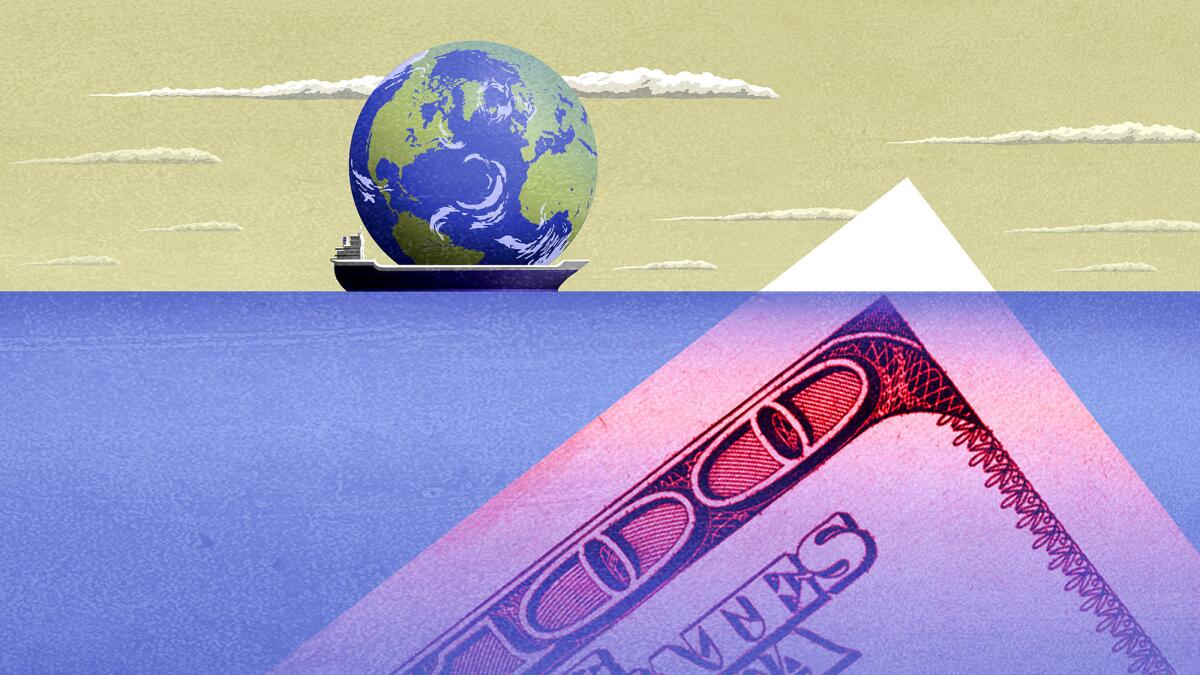Another financial crisis? Soaring global debt since 2008 raises risk as world economy sputters

Ancient Babylonian kings had a special tool at their disposal when economic or social conditions turned dicey: They would declare a “debt jubilee” and instantly wipe out borrowers’ loans, allowing average people deep in hock to start over with a clean slate.
It says something about the global economy in 2016 that the concept of a modern debt jubilee has been finding its way into some mainstream financial market discussions.
Eight years ago, unsustainably high debt was the root cause of the worst recession since the Great Depression. Yet world debt overall now is far above 2008 levels. And as with millions of American home buyers back then, many of today’s borrowers owe amounts that could become crushing burdens if the global economy should careen into a new recession.
The overstretched include plenty of governments. Total government debt outstanding worldwide was worrisome in 2008. It has since doubled to $59 trillion, according to Economist Intelligence.
But that is just one slice of the global debt pie. Add in household, corporate and bank debt and the grand total was a mind-boggling $199 trillion in mid-2014, up 40% since 2007, according to a study last year by McKinsey Global Institute.
One of the most dramatic increases has been in U.S. student debt. College loans outstanding have rocketed to $1.35 trillion from $589 billion in 2007, a 130% jump, Federal Reserve data show. That extraordinary burden on young people has become a political issue in the presidential election, at least for Democratic rivals Hillary Clinton and Bernie Sanders.
The irony for college students, and for other borrowers over the last eight years, is that many did exactly what governments and central banks wanted them to do to help end the Great Recession: Take advantage of super-low interest rates to borrow and spend.
Since the financial crash, “central bank policies have all been based on the theory that low interest rates will stimulate demand,” said Edward Yardeni, head of economic and market research firm Yardeni Research Inc. “But that theory now has exhausted itself.”
The reason: Whatever demand was spurred wasn’t enough to keep the world economy from slowing sharply in the last few years. Without a head of steam to keep advancing, the economy simply hasn’t paid off for many people, companies and governments that borrowed aggressively after 2007.
“The whole world is growing at a level that is far lower than in the pre-crisis environment,” said Jeffrey Rosenberg, chief investment strategist for fixed income at money management giant BlackRock Inc.
Real global growth averaged just 2.4% a year from 2012 through 2015. By contrast, growth averaged a brisk 3.7% from 2001 through 2010, including the Great Recession years.
Debt can be a good thing if it’s used productively and fuels economic growth, of course. But when the McKinsey study looked at government, household and corporate total debt relative to the size of the economies in 47 countries from 2007 through 2014, it found the ratio rose in every one -- in some cases substantially.
In the U.S., the debt-to-gross-domestic-product percentage edged up to 233% in 2014 from 217% in 2007. In Spain the figure jumped to 313% from 241% and in Japan it rose to 400% from 336%. There is no single “right” number, but obviously higher is riskier.
As debt has mounted, the overall effect has been to choke off growth rather than promote it.
“The problem with high debt levels is that it’s very paralyzing,” said Kenneth Rogoff, a Harvard University economics professor who has written extensively on the implications of debt.
In Greece, the flashpoint of Europe’s initial government debt crisis in 2009, debt woes have remained so onerous for local banks that “if you’re any kind of business, you can’t get a loan,” Rogoff said. That further starves the economy.
In Italy, where banks also are weighed down by bad loans, surging economic fears in the last two weeks have raised the specter that lenders will soon need new government help.
And in the U.S., the student-loan burden of the millennial generation has helped keep many of them from spending the way previous generations did when they were in their 20s and 30s. Consider: For the first time in 130 years, adults ages 18 to 34 are more likely to be living with parents than married or cohabiting with someone else, according to the Pew Research Center.
That deprives the economy of the traditionally heavy spending people do when they form a new household -- buying such things as furniture, televisions, window blinds and dishwasher soap.
For the Federal Reserve and the world’s other major central banks, this year has brought another stark reminder that the economy, and markets, aren’t buying the idea that policymakers’ traditional interest-rate tools could ignite faster growth.
The Fed in December lifted its benchmark short-term rate for the first time since 2006, raising it from near zero to a range of 0.25% to 0.50%. The heart of the Fed’s message was that things finally were getting back to normal in the economy, so rates should rise.
Yet by early January, fresh fears that China’s slowing economy would drag down the rest of the world drove investors into U.S. Treasury bonds as a haven, pushing yields down sharply. Markets stabilized in spring, then Treasury yields dived again in recent weeks after the British people stunned the world by voting to exit the European Union -- a decision that has further undermined confidence in Europe’s struggling economy.
By last week the bellwether 10-year Treasury note yield hit a record low 1.37%, down from 2.27% at the end of last year. What’s more, yields now actually are negative on a wide swath of European and Japanese government bonds. A negative yield means that rather than earn interest, investors agree to pay the government a small amount to safely hold their money in bonds.
The yield on 10-year German government bonds was negative 0.18% on Friday; on Japanese 10-year bonds it was negative 0.29%.
One message of negative interest rates is that some investors fear worse economic turmoil. That, in turn, stokes concern about borrowers’ ability to repay their lenders. Psychologically, “debt becomes like a dark cloud outside your door,” said Mohamed El-Erian, chief economic advisor to financial services firm Allianz.
This time, American homeowners aren’t likely to lead a debt crisis. But there are other candidates, including companies in emerging-market countries. Since 2008, “the most worrying development has been the steep rise in private-sector debt ... especially in several emerging-market economies,” the Bank for International Settlements, which is owned by the world’s central banks, warned in a report in March.
More than 5,200 emerging-market companies issued $1.1 trillion in bonds in 2014, double the level sold in 2010, according to Dealogic. Some chunk of that was used to finance or refinance more manufacturing or commodity-production capacity. But amid weak global growth, adding new factories or raw materials supplies can shrink profits for every player.
“The problem is what you created with the debt,” said Steven Ricchiuto, chief U.S. economist for Mizuho Securities. “The fundamental issue is we have excess supply.”
But will that necessarily lead to another “crisis”? BlackRock’s Rosenberg notes that some kind of global debt blowup has occurred roughly every seven or eight years since the early 1980s. That means 2016 would be right on schedule.
Inevitably, some banks and investors lose when lending money. That’s capitalism. The financial system is set up to deal with losses, on a modest scale, via foreclosure and bankruptcy laws.
The question is whether the global economy has reached a point where something more drastic is needed to fire up growth -- such as the Babylonian solution of massive debt forgiveness.
On the face of it, the “debt jubilee” idea seems preposterous. Unilaterally wiping out debt also would mean wiping out the assets of untold numbers of lenders and investors, including pension funds. When loan losses in the Great Recession threatened to destroy the banking system, U.S. and European governments stepped in with taxpayer money to save it -- and vowed “never again.”
Yet many experts believe that debt forgiveness for some desperate high-profile borrowers now is a certainty. Greece, which owes $359 billion, tops the list.
From a practical standpoint, “debt forgiveness is really, really hard,” El-Erian said. “There are enormous issues of fairness. But for Greece today the alternative is worse.” That alternative is the likelihood that the economy would remain in ruins.
Puerto Rico, too, clearly can’t repay the $70 billion it owes, Rogoff said.
Democratic presidential hopefuls Clinton and Sanders both have proposed ways to lessen the burden of federal college loans, mostly by speeding refinancing of the debt at lower interest rates. That is forgiveness in the sense that the government would earn less on the loans.
Many economists believe the world can continue to muddle through with high debt and slow growth for a while. It helps that central banks have bought up trillions in bonds since 2007 as a way to ease governments’ burdens. The crucial test will come if the global economy slides toward a new recession sooner than later.
With debt levels so high, and interest rates already near zero or below, the pressure would mount on central banks to use what Wall Street regards as the nuclear option: Start printing mountains of money for governments to hand directly to consumers -- to spend, pay off debt or save with no strings attached.
The political and economic risks of such a move would be enormous -- which is why it would only be considered as a desperation move.
For central banks, “it’s the last gasp,” Rosenberg said.
ALSO
Ever-lower interest rates leave investors with tough choices
‘Brexit’ boosts mortgage applications; Milken as mythic hero
Stocks close near record high, fueled by strong jobs report
More to Read
Inside the business of entertainment
The Wide Shot brings you news, analysis and insights on everything from streaming wars to production — and what it all means for the future.
You may occasionally receive promotional content from the Los Angeles Times.










